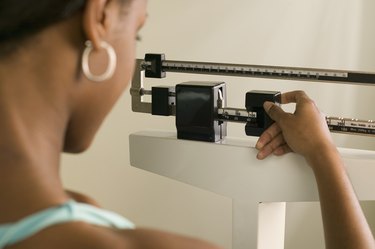
Our bodies have a love-hate relationship with fat. We need it, but it's way too easy to wind up hauling around too much body fat. That can trigger a cascade of health problems, including diabetes, high blood pressure and even heart disease.
But figuring out how much of your body weight is fat can be tricky business. Here, we break down the steps — and clue you in to the best way to shed any extra.
Video of the Day
Video of the Day
First, Understand Your Body's Composition
Your body is made up of lean tissue (including muscle, bone, connective tissue and internal organs) and fat tissue, comprised of essential and non-essential fat.
Essential fat is necessary to maintain basic bodily functions. Non-essential fat can be healthy too, as it provides substantial amounts of energy, according to the 2018 book Concepts of Fitness and Wellness.
In men and women, essential fat values are typically considered to be 3 percent and 12 percent respectively, according to the Georgia Highlands College report.
"Women naturally have a higher body fat percentage to afford the body reserves to create a fetus, sustain life and then go on to nourish a baby through breast milk," explains Dahlia Marin, RDN, a dietitian practicing in Newport Beach, California. "Women store more fat through our hips, thighs and breasts for this reason."
The American College of Sports Medicine, in its ACSM's Guidelines for Exercise Testing and Prescription (Tenth Edition), includes ranges of total fat that are "satisfactory" for good health.
- Men: 18 to 24 percent
- Women: 20 to 32 percent
Perhaps unsurprisingly, many of us go beyond those total body fat recommendations. Per the U.S. Centers for Disease Control and Prevention's National Center for Health Statistics, the national average total body fat percentages are:
- Men: 28 percent
- Women: 41 percent
Keep in mind, though, that several factors can affect those percentages. Professional athletes or even those who keep up consistent, demanding workout routines will have lower percentages.
Generally speaking, too, the older we get, the higher the percentage.
"As hormones begin to shift in one's 40s and later, at the same time activity usually declines, the greatest changes are seen in body fat composition," Marin tells LIVESTRONG.com. "The less one exercises, especially through strength-training and weight-bearing exercise, the more that change is seen and felt."
Related Reading
Next, Measure Your Body Fat Percentage
Most of the time, the term "measuring body fat" is referring to the percentage of body weight that is fat tissue, not the pounds. But once you know that percentage, you can figure out how many pounds of fat you're carrying around.
Some methods of determining your percentage of body fat are more reliable than others. Body fat scales send a mild electrical current through your body, but the home models can be less than accurate. Higher-end, more reliable ones can sometimes be found in doctor's offices and gyms.
A skinfold test performed using calipers is more precise than a home body fat scale, but still isn't foolproof. The American Council on Exercise (ACE) assigns it a 3.5 percent error rate. Its accuracy depends on the expertise of the person performing the test, as well as how overweight the subject is.
A 98-percent accurate measurement of body fat percentage — the costly DEXA scan — exists, but it can only be done in a clinical setting.
Get a quick estimate of your body fat percentage by plugging a few measurements into LIVESTRONG.com's Body Fat Calculator. Women need their hip, waist and neck measurements; men should have their neck and abdomen measurements handy.
Then Calculate Your Pounds of Body Fat
Now, figure out how many pounds of fat you own by multiplying your weight by your fat percentage.
So, for example, if you weigh 200 pounds and have 15 percent body fat, multiply .15 x 200 (don't forget the decimal point). That gives you 30, your number of pounds of fat.
How to Reduce Body Fat
At the end of the day, it all comes down to this: If you discovered you're carrying around an unhealthy amount of body fat, how do you get rid of it?
First, understand that if you lose weight with a drastic calorie deficit or without any exercise, you're likely to lose more muscle mass than fat. That's definitely not what you want.
Related Reading
So aim for a gradual loss of about 1 to 2 pounds per week. Keep your expectations modest: a drop of about 1 percent body fat per month.
Exercise is a must and should include both cardio and weight training. The cardio helps you use up fat for energy, while weight-training preserves and builds muscle. Increasing the lean protein in your diet as you cut calories helps too, since your body will turn to protein and muscle for energy.
Just remember that your success may not translate to the bathroom scale. A September 2018 study in the European Journal of Clinical Nutrition bore this out. When overweight participants underwent an exercise training program, their weight didn't change significantly, but their body fat levels were markedly reduced.
Related Reading
- American College of Sports Medicine: "ACSM's Guidelines for Exercise Testing and Prescription, 10th Edition"
- Centers for Disease Control and Prevention National Center for Health Statistics: "National Health and Nutrition Examination Survey"
- Concepts of Fitness and Wellness: "How Much Fat is Needed?"
- American Council on Exercise: "Percent Body Fat Norms for Men and Women"
- European Journal of Clinical Nutrition: "Exercise, Energy Balance and Body Composition"
- Married to Health: "Who We Are"